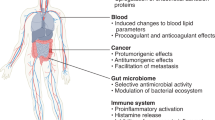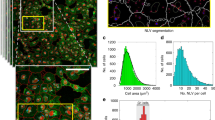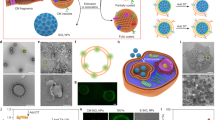Abstract
Nanostructures of different sizes, shapes and material properties have many applications in biomedical imaging, clinical diagnostics and therapeutics1,2,3,4,5,6. In spite of what has been achieved so far, a complete understanding of how cells interact with nanostructures of well-defined sizes, at the molecular level, remains poorly understood. Here we show that gold and silver nanoparticles coated with antibodies can regulate the process of membrane receptor internalization. The binding and activation of membrane receptors and subsequent protein expression strongly depend on nanoparticle size. Although all nanoparticles within the 2–100 nm size range were found to alter signalling processes essential for basic cell functions (including cell death)7, 40- and 50-nm nanoparticles demonstrated the greatest effect. These results show that nanoparticles should no longer be viewed as simple carriers for biomedical applications, but can also play an active role in mediating biological effects. The findings presented here may assist in the design of nanoscale delivery and therapeutic systems and provide insights into nanotoxicity.
This is a preview of subscription content, access via your institution
Access options
Subscribe to this journal
Receive 12 print issues and online access
$259.00 per year
only $21.58 per issue
Buy this article
- Purchase on Springer Link
- Instant access to full article PDF
Prices may be subject to local taxes which are calculated during checkout




Similar content being viewed by others
References
Xia, Y. et al. One-dimensional nanostructures: Synthesis, characterization, and applications. Adv. Mater. 15, 353–389 (2003).
Alivisatos, A. P. Semiconductor clusters, nanocrystals, and quantum dots. Science 271, 933–937 (1996).
Elghanian, R., Storhoff, J. J., Mucic, R. C., Letsinger, R. L. & Mirkin, C. A. Selective colorimetric detection of polynucleotides based on the distance-dependent optical properties of gold nanoparticles. Science 227, 1078–1081 (1997).
Cao, Y. C., Jin, R. & Mirkin, C. A. Nanoparticles with Raman spectroscopic fingerprints for DNA and RNA detection. Science 297, 1536–1540 (2002).
Klostranec, J. & Chan, W. C. W. Quantum dots in biological and biomedical research: recent progress and present challenges. Adv. Mater. 18, 1953–1964 (2006).
Hirsch, L. R. et al. Nanoshell-mediated near-infrared thermal therapy of tumors under magnetic resonance guidance. Proc. Natl Acad. Sci. USA 100, 13549–13554 (2003).
Datta, S. R., Brunet, A. & Greenberg, M. E. Cellular survival: a play in three Akts. Genes Dev. 13, 2905–2927 (1999).
Ullrich, A. & Schlessinger, J. Signal transduction by receptors with tyrosine kinase activity. Cell 61, 203–212 (1990).
Schlessinger, J. Cell signaling by receptor tyrosine kinases. Cell 103, 211–225 (2000).
Dubois, P. M., Stepinski, J., Urbain, J. & Sibley, C. H. Role of the transmembrane and cytoplasmic domains of surface IgM in endocytosis and signal transduction. Eur. J. Immunol. 22, 851–857 (1992).
Chithrani, B. D., Ghazani, A. A. & Chan, W. C. W. Determining the size and shape dependence of gold nanoparticle uptake into mammalian cells. Nano Lett. 6, 662–668 (2006).
Osaki, F., Kanamori, T., Sando, S., Sera, T. & Aoyama, Y. A quantum dot conjugated sugar ball and its cellular uptake. On the size effects of endocytosis in the subviral region. J. Am. Chem. Soc. 126, 6520–6521 (2004).
Shortkroff, S., Turell, M., Rice, K. & Thornhill T. S. Cellular response to nanoparticles. Mater. Res. Soc. Symp. Proc. 704, W11.5.1–W11.5.6 (2002).
Carter, P. et al. Humanization of an anti-p185HER2 antibody for human cancer therapy. Proc. Natl Acad. Sci. USA 89, 4285–4289 (1992).
Rubin, L. & Yarden, Y. The basic biology of Her2. Ann. Oncol. 12, S3–S8 (2001).
Geoghegan, W. D. & Ackerman, G. A. Adsorption of horseradish peroxidase, ovomucoid and anti-immunoglobulin to colloidal gold for the indirect detection of concanavalin A, wheat germ agglutinin and goat anti-human immunoglobulin G on cell surfaces at the electron microscopic level: a new method, theory and application. J. Histochem. Cytochem. 25, 1187–1200 (1977).
Chithrani, D. B. & Chan, W. C. W. Elucidating the mechanism of cellular uptake and removal of protein-coated gold nanoparticles of different sizes and shapes. Nano Lett. 7, 1542–1550 (2007).
Hommelgaard, A. M., Lerdrup, M. & van Deurs, B. Assocation with membrane protrusions makes ErbB2 an internalization-resistant receptor. Mol. Biol. Cell 15, 1557–1567 (2004).
Ghitescu, L. & Bendayan, M. Immunolabeling efficiency of protein A–gold complexes. J. Histochem. Cytochem. 38, 1523–1530 (1990).
Horrisberger, M. & Clerk, M. F. Labeling of colloidal gold with protein A. A quantitative study. Histochemistry 82, 219–223 (1985).
Gao, H., Shi, W. & Freund, L. B. Mechanics of receptor-mediated endocytosis. Proc. Natl Acad. Sci. USA 102, 9469–9474 (2005).
Andrews, N. C. Iron homeostasis: Insights from genetics and animal models. Nat. Rev. Genet. 1, 208–217 (2000).
Austin, C. D. et al. Endocytosis and sorting of ErbB2 and the site of action of cancer therapeutics Trastuzumab and Geldanamycin. Mol. Biol. Cell 15, 5268–5282 (2004).
Baulida, J., Kraus, M. H., Alimandi, M., Di Fiore, P. P. & Carpenter, G. All ErbB receptors other than the epidermal growth factor receptor are endocytosis impaired. J. Biol. Chem. 271, 5251–5257 (1996).
Vieira, A. V., Lamaze, C. & Schmid, S. L. Control of EGF receptor signaling by clathrin-mediated endocytosis. Science 274, 2086–2089 (1996).
Yakes, F. M. et al. Herceptin-induced inhibition of phosphatidylinositol-3 kinase and Akt is required for antibody-mediated effects on 27, Cyclin D1, and antitumour action. Cancer Res. 62, 4132–4141 (2002).
Frens, G. Controlled nucleation for the regulation of the particle size in monodisperse gold suspensions. Nature 241, 20–22 (1973).
Bonnard, C., Papermaster, D. S. & Kiraehenbuhl, J. P. The streptavidin–biotin bridge technique: Applications in light and electron microscope immunocytochemistry, in Immunolabeling for Electron Microscopy, 95–111 (Elsevier, New York, 1984).
Solomon, S. D., Bahadory, M., Jeyarajasingam, A. V., Rutkowsky, S. A. & Boritz, C. Synthesis and study of silver nanoparticles. J. Chem. Educ. 84, 322–325 (2007).
Acknowledgements
Financial support was provided by the Canadian Institutes of Health Research (W.C.W.C. and J.T.R.), Natural Sciences and Engineering Council of Canada (W.J., B.Y.S.K. and W.C.W.C.), Canadian Foundation for Innovation and Ontario Innovation Trust (W.C.W.C.), the Surgeon Scientist Program and the Ontario Ministry of Health (B.Y.S.K.). The authors wish to thank J. Klonstranec for helpful discussions, A. Manseur and T. Jennings for help with flow cytometry, B. Calvieri, S. Doyle and D. Holmyard with cell preparation for electron microscopy, and J. Oreopoulos from the Yip lab with confocal microscopy.
Author information
Authors and Affiliations
Contributions
W.J., B.Y.S.K. and W.C.W.C designed the experiments. W.J. and B.Y.S.K. performed the experiments and gathered the data. All authors discussed the results, co-wrote the paper and commented on the manuscript. W.J. and B.Y.S.K. contributed equally to this work.
Supplementary information
Rights and permissions
About this article
Cite this article
Jiang, W., Kim, B., Rutka, J. et al. Nanoparticle-mediated cellular response is size-dependent. Nature Nanotech 3, 145–150 (2008). https://doi.org/10.1038/nnano.2008.30
Received:
Accepted:
Published:
Issue Date:
DOI: https://doi.org/10.1038/nnano.2008.30
This article is cited by
-
Nano chitosan anchored copper-ferrite: a smart magnetic nanocomposite agent for drug delivery
Emergent Materials (2024)
-
Bringing sex toys out of the dark: exploring unmitigated risks
Microplastics and Nanoplastics (2023)
-
Carbon nanodots constructed by ginsenosides and their high inhibitory effect on neuroblastoma
Journal of Nanobiotechnology (2023)
-
Engineering nanomaterial physical characteristics for cancer immunotherapy
Nature Reviews Bioengineering (2023)
-
Green synthesis of nanoparticles from biodegradable waste extracts and their applications: a critical review
Nanotechnology for Environmental Engineering (2023)



